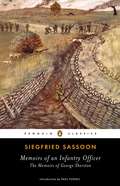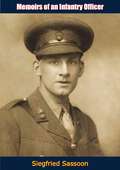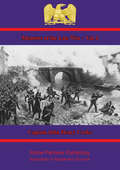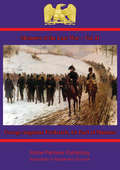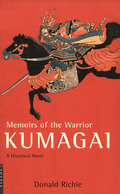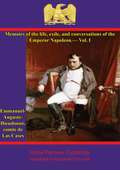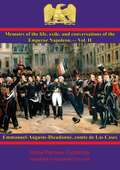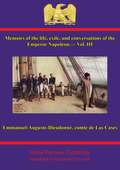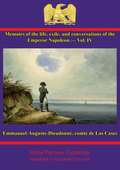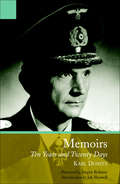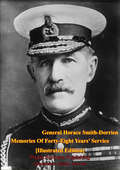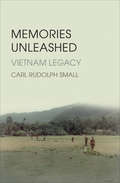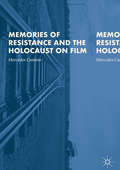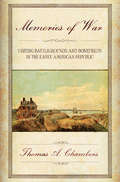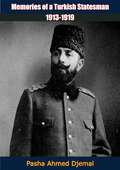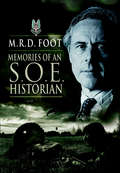- Table View
- List View
Memoirs of an Infantry Officer
by Paul Fussell Siegfried SassoonPersonal narratives of a British officer on the Western front during World War I. Copyright © Libri GmbH. All rights reserved.
Memoirs of an Infantry Officer (Memoirs of George Sherston #2)
by Siegfried SassoonThis autobiographical novel of the eminent English poet, Siegfried Sassoon was first published in 1930. The Memoirs of an Infantry Office, widely considered a classic among war books, tells of the author’s steady disillusionment with the Army—and of his ultimate rebellion against the cruel realities of war.Sassoon’s fluid, sensitive prose, the fine perceptions of the poet is spoken here in the voice of the average man. With charm and humor and quiet understatement, he has managed to articulate the hidden feelings of any sensitive man who in the normal course of his life is suddenly exposed to the nightmare of war.An unforgettable read.
Memoirs of the Late War – Vol. I. (Memoirs of the Late War #1)
by Captain John Henry CookeThis ebook is purpose built and is proof-read and re-type set from the original to provide an outstanding experience of reflowing text for an ebook reader.An anthology of memoirs of the Peninsular War and the abortive attack on Bergen-op-Zoom in 1814. This second volume includes two accounts from either end (chronologically) of Captain Cooke's narrative on the initial campaign into Spain in 1809 under the Duke of Wellington, recounted by the Earl of Munster. It also recounts the disastrous night attack on Bergen-op-Zoom by the British troops under Lord Lynedoch by Lieutenant Moodie, in which he leaves out none of the horrific carnage of the bungling coup de main. Title - Memoirs of the Late War - Vol. II Sub-Title - Series Name - Memoirs of the Late War Series Number --2 Authors -- Captain John Henry Cooke (????-????); George Augustus Frederick, 1st Earl of Munster (1794-1842); Lieutenant John W. D. Moodie (1789-1815) Text taken, whole and complete, from the edition published in 1831, London, by Henry Colbourn and Richard Bentley. Original - 321 pages.
Memoirs of the Late War – Vol. II. (Memoirs of the Late War #2)
by George Augustus Frederick, 1st Earl of MunsterThis ebook is purpose built and is proof-read and re-type set from the original to provide an outstanding experience of reflowing text for an ebook reader. An anthology of memoirs of the Peninsular War and the abortive attack on Bergen-op-Zoom in 1814. In this first volume, Captain Cooke recounts his experiences with the 43rd Foot at Ciudad Rodrigo, Badajoz, the battles of Salamanca, Vittoria, the Pyrenees, the Bidassoa, the Nive, Nivelle and Toulouse. As with many of the British officer memoirs, there is a tone of dry wit about his writing. Title - Memoirs of the Late War - Vol. I Sub-Title - Series Name - Memoirs of the Late War Series Number --1 Authors -- Captain John Henry Cooke (????-????); George Augustus Frederick, 1st Earl of Munster (1794-1842); Lieutenant John W. D. Moodie (1789-1815) Text taken, whole and complete, from the edition published in 1831, London, by Henry Colbourn and Richard Bentley. Original - 321 pages.
Memoirs of the War in Spain
by Anon Albert Jean Michel de RoccaThis ebook is purpose built and is proof-read and re-type set from the original to provide an outstanding experience of reflowing text for an ebook reader. Napoleon's eagles had triumphed over every adversary faced until his fateful decision to depose the Bourbons from the throne of Spain. He started a war that was to prove fatal to his ambitions, a war with the religious people who knew only the war of the knife. The Spaniards were unsuccessful in prosecuting a war on regular military lines, being crushed in a number of pitched battles against the French forces, but they started a campaign of guerilla warfare that was to make the French gains limited to the ground they stood on. Messengers would be attacked, stragglers murdered, provisions delayed, convoys waylaid. This form of warfare seemed alien to the French and, with the exception of Marshal Suchet in Catalonia, they could find no proper way of subduing the Spanish people. Michel de Rocca was a young hussar officer in 1808 and arriving early in the Peninsular War. He writes of the constant draining warfare: the need to be constantly on guard, the suspicious actions of the villagers, and the ambushes. Rocca appears to hold a grudge against the attitude of the Spanish, believing the war there to be rather inglorious and unjust; this was not the general feeling in the ranks of the French army, and was probably due to his Swiss ancestry and his association and later marriage to Madame de Staël (a staunch opponent of Napoleon). However, the brutal reprisals of the insurgents and the constant alertness wear him down as time goes on, and he is not unhappy to be removed from the war due to injuries sustained in an ambush. Text taken, whole and complete, Constable's Miscellany, Vol. XXVIII, Memorials of the Late War Vol. II. published Constable & Co, Edinburgh 1831. Original -193 pages Author - Albert Jean Michel de Rocca (1788-1818) Translator - Anon (????-????) Illustration - 1 Linked TOC
Memoirs of the Warrior Kumagai
by Donald Richie"A tour de force combining a commanding mastery of historical fact and detail, a comprehensive understanding of the human spirit, and a poetic quality of expression that transforms the hearts of all those it touches." -The Japan Foundation NewsletterKumagai Naozane was a Japanese warrior famous for having taken the head of the young and handsome samurai Atsumori. This episode has become one of the best-known and best-loved stories in the Japanese historical classic, The Heiké Story (Heike Monogatari). This book is a fictionalized version of Kumagai's own attempt to come to terms with his past-that real past which is his and that other past which he hears the monks inventing as they compose the text which will eventually become The Heiké Story.As the warrior remembers his past and compares it to its fictional parallel, he evokes the wonders of the city of Heiankyo (Kyoto); the wars which raised the Taira (Heike) clan to power and later reduced it to ruin at the hands of the Genji clan; the battles at the Uji River; life in the imperial court of the retired emperor Go-Shirakawa; and the celebrated final Taira battle-the naval encounter at Dannoura, where the infant emperor Antoku was delivered to the depths of the sea. Among the many pleasures of this brilliantly colored chronicle is how the common humanity of this honest, hopeless man transcends his time and milieu to speak to us, here and now.
Memoirs of the Warrior Kumagai
by Donald Richie"A tour de force combining a commanding mastery of historical fact and detail, a comprehensive understanding of the human spirit, and a poetic quality of expression that transforms the hearts of all those it touches." -The Japan Foundation NewsletterKumagai Naozane was a Japanese warrior famous for having taken the head of the young and handsome samurai Atsumori. This episode has become one of the best-known and best-loved stories in the Japanese historical classic, The Heiké Story (Heike Monogatari). This book is a fictionalized version of Kumagai's own attempt to come to terms with his past-that real past which is his and that other past which he hears the monks inventing as they compose the text which will eventually become The Heiké Story.As the warrior remembers his past and compares it to its fictional parallel, he evokes the wonders of the city of Heiankyo (Kyoto); the wars which raised the Taira (Heike) clan to power and later reduced it to ruin at the hands of the Genji clan; the battles at the Uji River; life in the imperial court of the retired emperor Go-Shirakawa; and the celebrated final Taira battle-the naval encounter at Dannoura, where the infant emperor Antoku was delivered to the depths of the sea. Among the many pleasures of this brilliantly colored chronicle is how the common humanity of this honest, hopeless man transcends his time and milieu to speak to us, here and now.
Memoirs of the life, exile, and conversations of the Emperor Napoleon, by the Count de Las Cases - Vol. I (Memoirs of the life, exile, and conversations of the Emperor Napoleon, by the Count de Las Cases #1)
by Comte Emmanuel-Auguste-Dieudonné de Las CasesBefore the shattering of the Napoleonic empire in 1815, Count Las Cases had served loyally for many years in the council of state. However, his most important service was to come after he followed his Emperor into exile on St. Helena. During his time with Napoleon on the "Rock in the Atlantic", he was to write down all that he heard from the Emperor's mouth, as clear a stream of his thoughts and reminiscences as were ever recorded. He was to eventually publish these entries as the "Memoirs of the life...", also known as the Mémorial de St. Hélène. They stand as a classic not just of the history of Napoleon's times, but also of the history of the first year of his banishment.Ranging from his earliest days in Corsica to the ranging battlefields of his career, Napoleon speaks through these pages as in no other of the sources left to us today. Essential reading and the birth of the Napoleonic legend. Author -- Las Cases, Emmanuel-Auguste-Dieudonné, comte de, 1766-1842.Text taken, whole and complete, from the edition published in 1855, New York, by Red Field.Original Page Count - 400 pages.Illustrations -- 4.
Memoirs of the life, exile, and conversations of the Emperor Napoleon, by the Count de Las Cases - Vol. II (Memoirs of the life, exile, and conversations of the Emperor Napoleon, by the Count de Las Cases #2)
by Comte Emmanuel-Auguste-Dieudonné de Las CasesBefore the shattering of the Napoleonic empire in 1815, Count Las Cases had served loyally for many years in the council of state. However, his most important service was to come after he followed his Emperor into exile on St. Helena. During his time with Napoleon on the "Rock in the Atlantic", he was to write down all that he heard from the Emperor's mouth, as clear a stream of his thoughts and reminiscences as were ever recorded. He was to eventually publish these entries as the "Memoirs of the life...", also known as the Mémorial de St. Hélène. They stand as a classic not just of the history of Napoleon's times, but also of the history of the first year of his banishment.Ranging from his earliest days in Corsica to the ranging battlefields of his career, Napoleon speaks through these pages as in no other of the sources left to us today. Essential reading and the birth of the Napoleonic legend.Author -- Las Cases, Emmanuel-Auguste-Dieudonné, comte de, 1766-1842.Text taken, whole and complete, from the edition published in 1855, New York, by Red Field.Original Page Count - 400 pages.Illustrations -- 4.
Memoirs of the life, exile, and conversations of the Emperor Napoleon, by the Count de Las Cases - Vol. III (Memoirs of the life, exile, and conversations of the Emperor Napoleon, by the Count de Las Cases #3)
by Comte Emmanuel-Auguste-Dieudonné de Las CasesBefore the shattering of the Napoleonic empire in 1815, Count Las Cases had served loyally for many years in the council of state. However, his most important service was to come after he followed his Emperor into exile on St. Helena. During his time with Napoleon on the "Rock in the Atlantic", he was to write down all that he heard from the Emperor's mouth, as clear a stream of his thoughts and reminiscences as were ever recorded. He was to eventually publish these entries as the "Memoirs of the life...", also known as the Mémorial de St. Hélène. They stand as a classic not just of the history of Napoleon's times, but also of the history of the first year of his banishment.Ranging from his earliest days in Corsica to the ranging battlefields of his career, Napoleon speaks through these pages as in no other of the sources left to us today. Essential reading and the birth of the Napoleonic legend.Author -- Las Cases, Emmanuel-Auguste-Dieudonné, comte de, 1766-1842.Text taken, whole and complete, from the edition published in 1855, New York, by Red Field.Original Page Count - 400 pages.Illustrations -- 4.
Memoirs of the life, exile, and conversations of the Emperor Napoleon, by the Count de Las Cases - Vol. IV (Memoirs of the life, exile, and conversations of the Emperor Napoleon, by the Count de Las Cases #4)
by Comte Emmanuel-Auguste-Dieudonné de Las CasesBefore the shattering of the Napoleonic empire in 1815, Count Las Cases had served loyally for many years in the council of state. However, his most important service was to come after he followed his Emperor into exile on St. Helena. During his time with Napoleon on the "Rock in the Atlantic", he was to write down all that he heard from the Emperor's mouth, as clear a stream of his thoughts and reminiscences as were ever recorded. He was to eventually publish these entries as the "Memoirs of the life...", also known as the Mémorial de St. Hélène. They stand as a classic not just of the history of Napoleon's times, but also of the history of the first year of his banishment.Ranging from his earliest days in Corsica to the ranging battlefields of his career, Napoleon speaks through these pages as in no other of the sources left to us today. Essential reading and the birth of the Napoleonic legend.Author -- Las Cases, Emmanuel-Auguste-Dieudonné, comte de, 1766-1842.Text taken, whole and complete, from the edition published in 1855, New York, by Red Field.Original Page Count - 412 pages.Illustrations -- 4.
Memoirs: Ten Years and Twenty Days
by Karl Doenitz&“A fascinating and detailed account of the German navy&’s war, mostly covering U-boat activities&” by the man who succeeded Hitler as Fuhrer (Damien Burke, author of TSR2: Britain&’s Lost Bomber). This is the story of the last world war, as told by Grand Admiral Karl Döenitz himself. His memoir covers his early career with submarines in the First World War and follows both his successes and failures through the Second World War, with great detail on the way the U-boat campaign was waged, as told by the man who invented U-boat tactics. Döenitz includes details of the U-boat campaigns during the Second World War as well as the opinions, ideas and commentary on the period. Of particular interest are the comments regarding British and American conduct during the war. This is an important social document and an invaluable source for any student of the last war. After becoming the last Fuhrer of Germany after Hitler&’s suicide in May 1945, Karl Döenitz spent ten years and twenty days in Spandau Prison having been convicted of war crimes following a trial at Nuremberg. &“A very interesting book looking at the war in the Atlantic from the German side . . . one of the best accounts of the Battle of the Atlantic.&”—UK Historian
Memorial Day Mission
by Debbie TaylorBomber’s great grandfather was a Tuskegee Airmen during World War II. They were the first African Americans to ever become pilots! Bomber can’t wait for his “Poppy” to tell his class about being a pilot when an accident happens. Bomber now has to give the presentation! Will he get over his fear to tell the story of his great grandfather?
Memorial Mania: Public Feeling in America
by Erika DossIn the past few decades, thousands of new memorials to executed witches, victims of terrorism, and dead astronauts, along with those that pay tribute to civil rights, organ donors, and the end of Communism have dotted the American landscape. Equally ubiquitous, though until now less the subject of serious inquiry, are temporary memorials: spontaneous offerings of flowers and candles that materialize at sites of tragic and traumatic death. In Memorial Mania, Erika Doss argues that these memorials underscore our obsession with issues of memory and history, and the urgent desire to express—and claim—those issues in visibly public contexts. Doss shows how this desire to memorialize the past disposes itself to individual anniversaries and personal grievances, to stories of tragedy and trauma, and to the social and political agendas of diverse numbers of Americans. By offering a framework for understanding these sites, Doss engages the larger issues behind our culture of commemoration. Driven by heated struggles over identity and the politics of representation, Memorial Mania is a testament to the fevered pitch of public feelings in America today.
Memories Of Forty-Eight Years’ Service [Illustrated Edition]
by General Sir Horace Lockwood Smith-DorrienThe memoirs of a veteran general of the British army who fought through the heat of the South African kopjes and plains to the mud, rain and misery at Ypres. Illustrated with 11 photographs and 27 maps and plans. He fought in many of the Imperial wars in Africa, and was distinguished as one of only five British officers to escape the utter slaughter at the battle of Isandlwana in 1878 during the Zulu War.His enduring modern fame rests on his achievements during the First World War, when he was selected to command one of the two corps of the small British Expeditionary Force in 1914 by Lord Kitchener, firmly believing that Smith-Dorrien would stand up to the commander Sir John French. As the B.E.F. struggled back through Belgium in the face of German forces that greatly outnumbered their own troops in 1914, the strain on the men began to show; they thought that they had outfought the Germans at the battle of Mons, but physically they could not fight and outmarch their foes. Seeing the tired and resentful expressions on his men's faces, Smith-Dorrien came to a fateful decision: the safe retreat of the footsore B.E.F. could only be carried out if the Germans were slowed down. In defiance of his orders from Sir John French to keep going, he gathered as many of his soldiers as could stand and fought a brilliant rearguard action at Le Cateau, now regarded as pivotal in saving the B.E.F. from piecemeal destruction. Castigated in public and in private military circles for his decision at the time, he accelerated his downfall by his forthright attitude to his superior, Sir John French. After pointing out the flaws in French's wasteful tactics following a particularly disastrous counterattack at Ypres, Smith-Dorrien had gone too far and was sent home under the excuse of "ill-health", never to hold a field command again.His memoirs are detailed, exciting and a good balance to the highly inventive writings of Sir John French.
Memories Unleashed: Vietnam Legacy
by Carl Rudolph SmallAfter forty years of silence, a Vietnam veteran shares powerful personal memories of his year of combat. This memoir of the Vietnam War is structured as a series of short vignettes that convey the emotional and physical landscape of the Vietnam War. It is a window into the war from the perspective of &“the marine&”—the author, who served in a rapid response assault force. Carl Rudolph Small joined the Corps in 1969 at nineteen years old, coming from a small Vermont farming community. After boot camp and specialty training he landed in Da Nang as a private first class. With three battlefield promotions in eight months, he soon became a platoon sergeant. Small did not talk of his experiences in Vietnam over the next forty years—but now, he has written this book so that veterans&’ families, including his own, can better understand what their loved ones experienced. It brings you inside the mind of the marine; you see what he sees, feel what he feels. You know him and where he comes from, what he is thinking, why he makes the decisions he needs to make.Memories Unleashed is an assemblage of memories, consisting of stories that stand alone to create a whole greater than the sum of its parts. It addresses the warrior, the lives of innocent people caught up in the war, and the American and Vietnamese families impacted by those who fought. &“A fierce focused account of one man&’s year in the kind of close combat that was hard to talk about and hard to forget.&” —Tom Powers
Memories of Resistance and the Holocaust on Film
by Mercedes CaminoThis book investigates cinematic representations of the murder of European Jews and civilian opposition to Nazi occupation from the war up until the twenty-first century. The study exposes a chronology of the conflict’s memorialization whose geo-political alignments are demarcated by vectors of time and space—or ‘chronotopes’, using Mikhail Bakhtin’s term. Camino shows such chronotopes to be first defined by the main allies; the USA, USSR and UK; and then subsequently expanding from the geographical and political centres of the occupation; France, the USSR and Poland. Films from Western and Eastern Europe and the USA are treated as primary and secondary sources of the conflict. These sources contribute to a sentient or emotional history that privileges affect and construct what Michel Foucault labels biopolitics. These cinematic narratives, which are often based on memoirs of resistance fighters like Joseph Kessel or Holocaust survivors such as Primo Levi and Wanda Jakubowska, evoke the past in what Marianne Hirsch has described as ‘post-memory’.
Memories of War: Visiting Battlegrounds and Bonefields in the Early American Republic
by Thomas A. ChambersEven in the midst of the Civil War, its battlefields were being dedicated as hallowed ground. Today, those sites are among the most visited places in the United States. In contrast, the battlegrounds of the Revolutionary War had seemingly been forgotten in the aftermath of the conflict in which the nation forged its independence. Decades after the signing of the Constitution, the battlefields of Yorktown, Saratoga, Fort Moultrie, Ticonderoga, Guilford Courthouse, Kings Mountain, and Cowpens, among others, were unmarked except for crumbling forts and overgrown ramparts. Not until the late 1820s did Americans begin to recognize the importance of these places. In Memories of War, Thomas A. Chambers recounts America's rediscovery of its early national history through the rise of battlefield tourism in the first half of the nineteenth century. Travelers in this period, Chambers finds, wanted more than recitations of regimental movements when they visited battlefields; they desired experiences that evoked strong emotions and leant meaning to the bleached bones and decaying fortifications of a past age. Chambers traces this impulse through efforts to commemorate Braddock's Field and Ticonderoga, the cultivated landscapes masking the violent past of the Hudson River valley, the overgrown ramparts of Southern war sites, and the scenic vistas at War of 1812 battlefields along the Niagara River. Describing a progression from neglect to the Romantic embrace of the landscape and then to ritualized remembrance, Chambers brings his narrative up to the beginning of the Civil War, during and after which the memorialization of such sites became routine, assuming significant political and cultural power in the American imagination.
Memories of a Turkish Statesman, 1913-1919
by Pasha Ahmed DjemalMY personal participation in general politics in the Ottoman Empire begins with the coup d’état of January 23, 1913.On the evening of that day I left the headquarters of the Lines of Communication Inspectorate and went to the Sublime Porte, to which a great crowd was flocking at the time.At that moment Mahmud Shefket Pasha, who had been appointed Grand Vizier a few hours before, returned from the Imperial Palace and met me at the entrance to the Grand Vizier’s palace.He had hardly seen me before he called out: “Djemal Bey, I want you to take over the Military Governorship of Constantinople at once and you must not lose a minute in taking all measures you think necessary for the preservation of order and confidence in the capital.”As I have said, my assumption of the highly important and equally responsible office of Military Governor of Constantinople meant my direct participation in general politics in my Fatherland. I thus find myself compelled to start my memoirs at that point.—Pasha Ahmed Djemal
Memories of an S.O.E. Historian
by M. R. FootThe historian of the British World War II intelligence organization chronicles his life and service career in this memoir.Michael (M.R.D.) Foot enjoys the rare distinction of being the only person referred to by his real name in a John Le Carré novel. A highly significant tribute to the man entrusted with writing the official record of the Special Operations Executive. He authored first (1966) the History of SOE in France and twenty years later the highly sensitive accounts of SOE operations in Belgium and Holland (which the Germans infiltrated with disastrous results). With his own war service background and academic reputation M.R.D. was an inspired choice for these historic tasks. He was fearless in pursuit of the truth and in thwarting bureaucratic attempts to muzzle him. His war exploits make thrilling reading. His behind-the-lines mission to track down a notorious SD interrogator went badly wrong, and he only just escaped with his life. His career has brought him into close contact with an astonishing cast of characters, and his tongue-in-cheek account of academic life makes lively reading.
